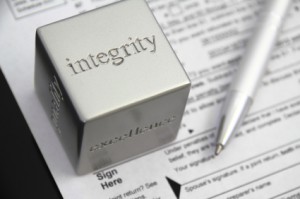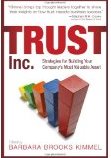The Easiest Way to Create Trust
 I was in a Costco store the other day, and noticed the man whose photo you see attached here. I was struck by his t-shirt: in bold, large font, it reads, “Because I Said I Would.”
I was in a Costco store the other day, and noticed the man whose photo you see attached here. I was struck by his t-shirt: in bold, large font, it reads, “Because I Said I Would.”
That got me thinking. As founder of Trusted Advisor Associates, one of the most common questions I get over the years is some variation on, “How do I go about creating trust?”
There are many variations on that question: What’s the fastest way to create trust? What’s the most enduring way to create trust? What’s the most cost-effective way, the highest-value way, the most accessible way, and so forth.
I’ve written elsewhere about some of those, but this t-shirt reminded me of a very important one – What’s the Easiest Way to Create Trust?
So here it is (and then we’ll come back to our t-shirt guy).
The Easiest Way to Create Trust
The answer (drumroll) is – make a lot of promises, and then keep them.
Here are several reasons I call that the ‘easiest’ way:
- We all know how to make promises; we make many of them every day (“I’ll see you at 10:00,” “I’ll have that done by Tuesday,” “I’ll take care of it for you.”)
- Most promises aren’t really that difficult to fulfill: most of us don’t wildly over-promise, or promise things that are massively outside our ability to complete.
- Kept promises are easy to see, and easy to credit. They go into an account often labelled “integrity,” a not-so-trivial attribute to be credited with.
- Kept promises fall squarely within one of the four Trust Equation components – Reliability. In fact, kept promises are pretty much the main way we establish our rating of someone’s reliability.
- It’s not that hard to come up with a list of viable promises you can make, which then offers you a list of promises you can keep. Most of our client relationships (indeed, all relationships) have frequent components of timeliness, or of quality of delivery.
But notice: if it’s so easy to keep promises, and so valuable to keep them – then why aren’t we all paragons of Reliability virtue? Because let’s be honest – we’re not.
Where Promise-Keeping Falls Down
There are three areas where we fall down in promise-keeping.
Fear. Ironically, the biggest failure of promise-keeping is failure to make a promise in the first place! Nobody can fault you – or credit you – with a promise you never made to begin with.
Why do we fail to make promises in the first place? Usually, because we fear being held accountable. It feels safer to say, “I’ll get it to you before the end of the week,” or “I’ll be there around ten-ish,” because it leaves you lots of wiggle-room. That way – we like to kid ourselves – there’s sufficient vagueness that no one will blame us.
We forget that the failure to be blamed for something that didn’t happen doesn’t rank nearly as high on the trustworthiness list as the fulfillment of a promise made. It’s a classic case of avoiding a risk, and thereby incurring a larger, longer-term risk – the risk of never having taken a risk. And remember – without risk, trust never exists.
Optimism. Another failure of promise-keeping is our own well-intended optimism. We really want to get that document to them by close of business Wednesday, because we sense that they’d really like it by then. So, we optimistically say we’ll do something that frankly, isn’t realistic, and then rationalize missing it later by telling ourselves it really wasn’t that important.
Sand-bagging. This one is pernicious. Are you a believer in “under-promise and over-deliver?” Because if you are – and let me put this provocatively – you believe in lying. Either you are lying in knowingly making a false promise, or in knowingly confounding the Other’s expectations. Or both!
The problem with sand-bagging is that it compounds. You may generate delight the first time, but when you do it again, the Other party figures out your game. Even if it doesn’t annoy them, they begin to discount your promises by the amount you lied the first two times. You are no longer believed. Which means your promises can’t be trusted. (Ask any firm that has tried to consistently sandbag Wall Street with calculatedly discounted earnings estimates).
The Costco Guy with the T-shirt
Back to our friend. When I saw him, I asked if I could take his photo; he readily agreed. I was very curious about whether he intended his t-shirt to mean what I would mean by that phrase – which is all the trust stuff I wrote about above.
Here’s what he said.
“It’s a personal statement to myself. I wear it to remind myself to keep my word. That’s really important to me, in all things.”
Pretty much what I’d hoped he’d say. I agree with him. And while we just went our ways, my guess is that if I’d talked to him further, he would probably have agreed with me that:
- Promises come up a lot, every day
- Keeping them isn’t all that hard – if you just focus on keeping them, and not be distracted by all the little temptations to let them slide, or to avoid making them in the first place
- A lifetime lived by making a lot of promises, and pointedly keeping them, is a terrific way to create trust in our relationships with others.
Anyway, that’s my take on the easiest way to create trust: make a lot of promises and keep them.
And, since I stupidly forgot to ask the gentleman’s name, if you know him, please reach out and send this blogpost to him – with my thanks, and my congratulations.

 Like trust, integrity is something we all talk about, meaning many different things, but always assuming that everyone else means just what we do. That leads to some vagueness and confusion. But a careful examination of how we use the words in common language is useful.
Like trust, integrity is something we all talk about, meaning many different things, but always assuming that everyone else means just what we do. That leads to some vagueness and confusion. But a careful examination of how we use the words in common language is useful.
 Credibility is one piece of the bedrock of trust. If people doubt what you say, all else is called into doubt, including competence and good intentions. If others don’t believe what you tell them, they won’t take your advice, they won’t buy from you, they won’t speak well of you, they won’t refer you on to others, and they will generally make it harder for you to deal with them.
Credibility is one piece of the bedrock of trust. If people doubt what you say, all else is called into doubt, including competence and good intentions. If others don’t believe what you tell them, they won’t take your advice, they won’t buy from you, they won’t speak well of you, they won’t refer you on to others, and they will generally make it harder for you to deal with them. My last three posts –
My last three posts –  People don’t trust companies very much.
People don’t trust companies very much. Some will recall comic
Some will recall comic